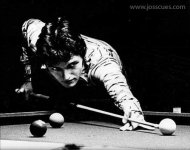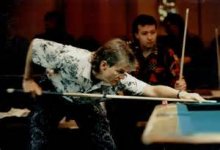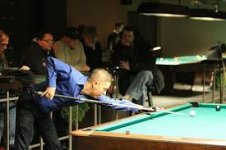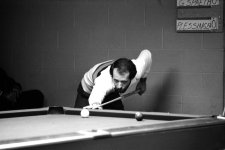You are using an out of date browser. It may not display this or other websites correctly.
You should upgrade or use an alternative browser.
You should upgrade or use an alternative browser.
How to Use the Masse' Shot to Curve Around Obstructing Balls
- Thread starter CJ Wiley
- Start date
But I believe coiling, in terms of biomechanics, refers to a sequencing of contrations of various muscles in order to create a degree of eccentric contraction in the following muscle being contracted, as placing muscles in eccentric contraction allows them to contract with significantly more force.
Some call it timing, but it's really about the timing of contractions and the coordination there in.
Hi Colin,
For every action there is a reaction.
Hi Colin,
For every action there is a reaction.
Rick,
Try flicking a coin with your thumb without a concentric contraction using another finger, versus using a resisting finger.
The force increment is 10 fold, and dissolves platitudes about Newtonian physics as you enter the realm of bio-mechanics.
Colin
Edit: I'm not saying that the laws of physics are wrong or irrelevant, but pointing out the weird way that muscle cells contract and produce force. They can exert many times more force when eccentrically contracting than they can during the opposite (lengthening) phase and this has been tested comprehensively.
Last edited:
Rick,
Try flicking a coin with your thumb without a concentric contraction using another finger, versus using a resisting finger.
The force increment is 10 fold, and dissolves platitudes about Newtonian physics as you enter the realm of bio-mechanics.
Colin
Edit: I'm not saying that the laws of physics are wrong or irrelevant, but pointing out the weird way that muscle cells contract and produce force. They can exert many times more force when eccentrically contracting than they can during the opposite (lengthening) phase and this has been tested comprehensively.
Hi Colin,
I was not disagreeing with you. Constraining is an action that has a reaction.
I was just trying to put it in it's most simple form.
Did you mention a picture?
Later,
Rick
But these are mere natural facts, which can't compete with made facts. Facts are easily made through repetition of claims and simply ignoring contradictions and objections. And made facts are more compelling because they're tailored for a specific use, often on the spot.All true.....eccentric contraction - lengthening of a muscle while it contracts (letting a heavy weight down) - vs concentric contraction - shortening of a muscle while it contracts (lifting a heavy weight).
I think you'd agree that what your talking about here has no use what so ever in a pool stroke. The example you used in post #63 about flicking a coin.....man, it'd be nice if we could harness that power (10 fold) when we're breaking the balls.
"Coiling of the shoulder", mentioned by CJ in post #50 and commented on by me in posts #53 & 57, I think was more about a winding up certain muscles groups. Anything that is winded up will want to unwind, and usually very quickly......think of winding up a rubber band and then letting go. And even here, "coiling" or winding up of muscles, I think, has nothing much to do with a pool stroke either.....one of the points I was trying to make in post #53.
Example: In golf one wants roughly a 90 degree shoulder turn and roughly a 45 degree hip turn with a resultant winding up or "coiling" of the big muscles in between.
DTL
Good luck though,
pj
chgo
When a player knows how to coil the shoulder correctly it won't matter how high they have to elevate their cue, This means they can "aim" the shot through precise alignment. Then, of course, you have to practice the acceleration at the moment of contact, which, ironically, is the same as any other shot.....if they fundamentals are correct, so that the shoulder, arm, wrist, and hand is connected to the tip through the cue stick (the hips are connected too)......how many players do this correctly?
Very few....very few indeed.
Efren is the one that I saw use this technique when performing the masse' shot. I simply modeled it and learned it in a matter of ten minutes....ONLY because my shoulder motion is correct, if this wasn't the case I could not learn it so quickly.
Coiling the shoulder is vitally important to hitting the masse' shot accurately. imho
I understand the idea of coiling is a collecting or gathering of the muscles in and around the shoulder for a certain movement or even non movement. You're referring to positioning the shoulder, how?
You've mentioned this before , but we've never got any discussion going on about it.
Best,
Mike
I'd disagree that we can't utilize this in a pool stroke. My video on power breaking explains how it can be utilized. https://www.youtube.com/watch?v=xW1tsONEI_UAll true.....eccentric contraction - lengthening of a muscle while it contracts (letting a heavy weight down) - vs concentric contraction - shortening of a muscle while it contracts (lifting a heavy weight).
I think you'd agree that what you're talking about here has no use what so ever in a pool stroke. The example you used in post #63 about flicking a coin.....man, it'd be nice if we could harness that power (10 fold) when we're breaking the balls.
"Coiling of the shoulder", mentioned by CJ in post #50 and commented on by me in posts #53 & 57, I think was more about a winding up certain muscles groups. Anything that is winded up will want to unwind, and usually very quickly......think of winding up a rubber band and then letting go.* And even here, "coiling" or winding up of muscles, I think, has nothing much to do with a pool stroke either, certainly not "vitally important".....one of the points I was trying to make in post #53.
* Example: In golf one wants roughly a 90 degree shoulder turn and roughly a 45 degree hip turn with a resultant winding up or "coiling" of the big muscles in between.
DTL
If the shoulder moves forward, there can be a lengthening of the biceps, pectoral and lats which allows them to contract with greater force, then the upper arm moves forward, lengthening the forearm muscles, which lengthens muscles in the wrist allowing them to contract eccentrically.
Coordinating these movements to maximize the lengthening force applied at each stage significantly increases the potential to accelerate the cue. If all limbs just uncoil together, there will be much less power.
Hi Rick,Hi Colin,
I was not disagreeing with you. Constraining is an action that has a reaction.
I was just trying to put it in it's most simple form.
Did you mention a picture?
Later,
Rick
This pic shows the thumb being resisted by the index finger. If you try to flick a coin just with the thumb alone, you'll see it is hard to flick a coin more than an inch high.

Throughout such complex movements over distance, such as a break shot or a golf swing, I think 20% or so additional power would be near the limit.Not buying all that, lol. I have a Masters in Physician Assistant Studies and tried to follow along but I doubt all that is happening.
I can buy the flicking a coin thing....."10 fold" the power vs the thumb alone. If you can do this with your break shot you'd be busting the balls apart.....? 75 mph would only be 3X the avg pro speed.
Anyway, that's only one shot and we're talking about your avg pool strokes during a game where one tries to stay perfectly still and mainly use the triceps/biceps to execute the shot.
In the pool stroke, the most significant contribution I've found comes via a wrist flick, but performing it well soon leads to some tendonitis.
I've spent 20 years actually training in various power movements, shot putt, discus, javelin, highland games throwing events, long drive golfing, jumping etc. You get to feel when the timing of movements and contractions begin utilizing this effect.
The wrist flick..........adds last second speed to the stroke. Perhaps this is where some of that extra 20% is coming from?
With all that training you talked about, no wonder you're able to break really hard. :thumbup:
There's been several discussions in the past of the wrist flick and its pros and cons. The consensus in one camp is it doesn't really add any advantage or power into the stroke. The other camp disagrees and says it can be a decided addition, especially to firmer strokes.
I'm in the second camp, where experience has shown certain advantages to using it.
Mini thread hijack.
Best,
Mike
I'm in with Colin & Mike.
Our complete body & it's biomechanics are there & should be considered & probably can & should be used from our toes to our fingertips which includes the shoulder & the wrist.
Don't 'load' the wrists or 'spend' them early in baseball or golf & power has been either not employed or wasted. Note the timing aspect of the second example.
One might say that that much power is not needed in pool other than the break.
The thing is, 'power' is not always about maximum power but a level of power with a lesser or minimum of overall effort. Why make a long full arm swing when a very small arm movement with a timed wrist 'release' can do the job that's required. By 'timed' I certainly do not mean a conscious effort. In fact, it is the conscious effort of keeping them out of play that can & IMO should be done away with for most shots & employed for only other specific shots.
In golf, many fail to execute the less than full swing shots like pitches & long chips because they change the swing to a different one than their full swing. It should be a mini version with a different set up. (Tiger Woods sort of just said such for why his short game has suffered so after making a change in his full swing that he has not yet put well into the short stuff.) The wrists should still be in play but just perhaps to a lesser degree. Why take the wrists out of play & then require a larger body action than is needed for such a small shot.
We have wrists & they are there for a reason.
Is this a larger hi-jack? Sorry.
Best 2 All,
Rick
Our complete body & it's biomechanics are there & should be considered & probably can & should be used from our toes to our fingertips which includes the shoulder & the wrist.
Don't 'load' the wrists or 'spend' them early in baseball or golf & power has been either not employed or wasted. Note the timing aspect of the second example.
One might say that that much power is not needed in pool other than the break.
The thing is, 'power' is not always about maximum power but a level of power with a lesser or minimum of overall effort. Why make a long full arm swing when a very small arm movement with a timed wrist 'release' can do the job that's required. By 'timed' I certainly do not mean a conscious effort. In fact, it is the conscious effort of keeping them out of play that can & IMO should be done away with for most shots & employed for only other specific shots.
In golf, many fail to execute the less than full swing shots like pitches & long chips because they change the swing to a different one than their full swing. It should be a mini version with a different set up. (Tiger Woods sort of just said such for why his short game has suffered so after making a change in his full swing that he has not yet put well into the short stuff.) The wrists should still be in play but just perhaps to a lesser degree. Why take the wrists out of play & then require a larger body action than is needed for such a small shot.
We have wrists & they are there for a reason.
Is this a larger hi-jack? Sorry.
Best 2 All,
Rick
Last edited:
I'm familiar with the piston and pendulum strokes..... I mentioned them in my post #68. I'm not familiar with the other two........any champions using those?
What kind do you use?.........just asking, I haven't seen you post any videos of yourself playing.
DTL
ps Lets get back to what this thread was about after we hijacked it, lol,.............WTF is, or why is "shoulder coil" so "vitally important"?
My stroke is all natural & what I gravitated to as a teenage. My only real stroke related focus is to move the cue straight in both the vertical & horizontal planes. There's probably a lil bit of every type of 'defined' stroke in mine. It's a pendulum-scissors-piston-push -back-pull-forward-piston-push-forward-piston stroke.:wink:
And sometimes I feel it in my shoulder & my shoulder blade area is often tight & susceptible to a cramp when I throw it over the seat of my car to back the car up.
Are we back on topic?
Best 2 You & All,
Rick




